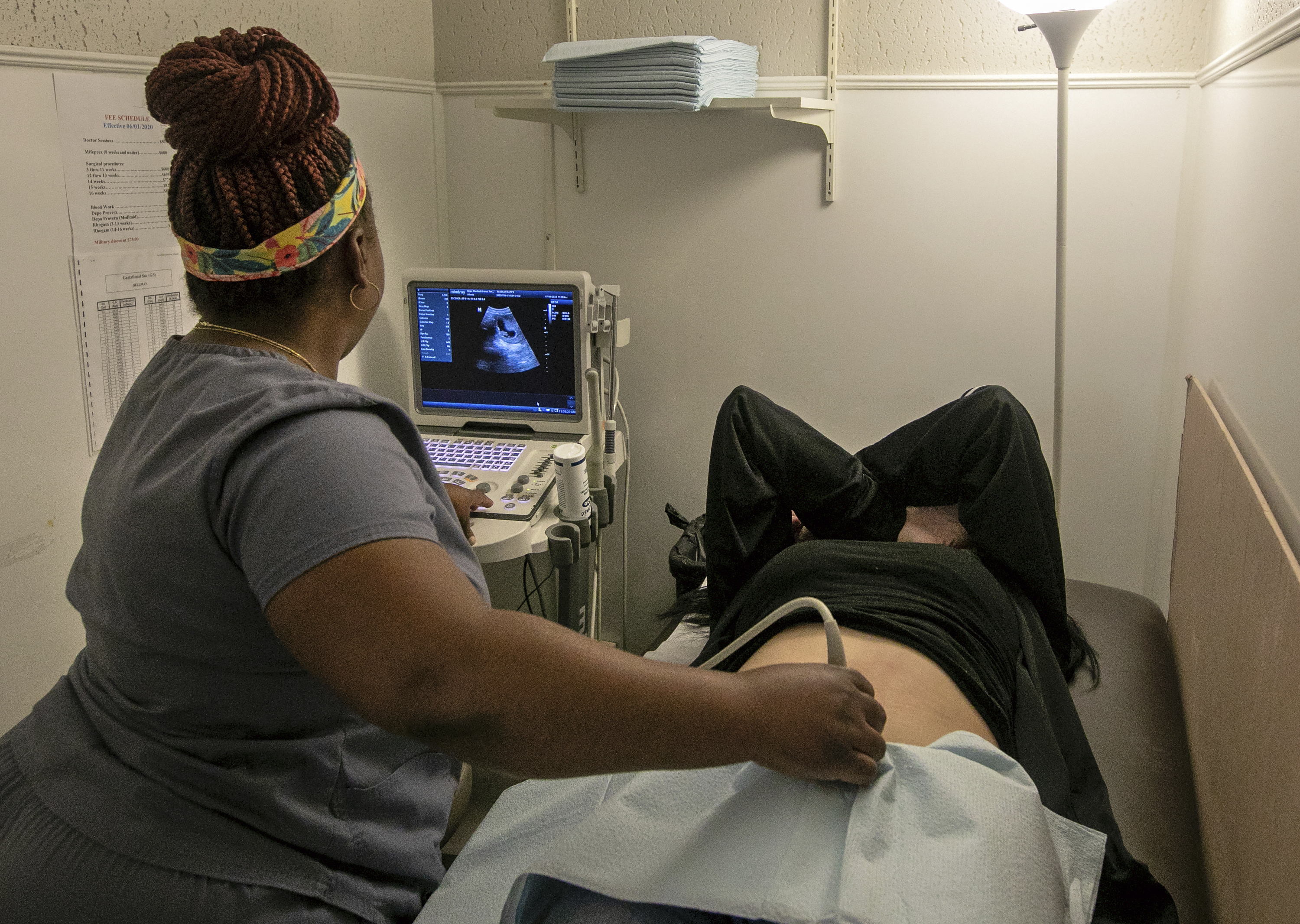
WASHINGTON — In Utah, extra of Dr. Cara Heuser’s maternal-fetal medication sufferers are requesting early ultrasounds, hoping to detect severe issues in time to decide on whether or not to proceed the being pregnant or have an abortion.
In North Carolina, extra obstetrics sufferers of Dr. Clayton Alfonso and his colleagues are counting on early genetic screenings that don’t present a agency prognosis.
The explanation? New state abortion restrictions imply the clock is ticking.
Since Roe v. Wade was overturned, many well being care suppliers say an growing variety of sufferers are deciding the destiny of their pregnancies primarily based on no matter info they’ll collect earlier than state bans kick in. However early ultrasounds present far much less in regards to the situation of a fetus than later ones. And genetic screenings could also be inaccurate.
If you discover out your fetus has a major problem, “you’re in disaster mode,” mentioned Sabrina Fletcher, a doula who has helped ladies on this predicament. “You’re not enthusiastic about authorized repercussions and (state) cutoff dates, and but we’re pressured to.”
About half of states ban abortion or limit it after a sure level in being pregnant. In Utah, it’s usually unlawful after the 18-week mark; in North Carolina, after 12 weeks.
This leaves thousands and thousands of ladies in roughly 14 states with no choice to get follow-up diagnostic exams in time to feasibly have an abortion there in the event that they needed, a paper revealed final March within the journal Obstetrics and Gynecology discovered. Much more states have abortion cutoffs too early for mid-pregnancy ultrasounds.
“Extra persons are looking for these items out earlier to attempt to match throughout the confines of legal guidelines that in my thoughts don’t have a spot in medical apply,” mentioned Alfonso, an OB-GYN at Duke College.
Checking for prenatal issues
When performed on the proper time, docs mentioned prenatal testing can establish issues and assist mother and father resolve whether or not to proceed a being pregnant or put together for a child’s complicated wants after supply.
One of the crucial widespread exams is the 20-week ultrasound, generally referred to as an “anatomy scan.” It checks on the fetal coronary heart, mind, backbone, limbs and different components of the physique, on the lookout for indicators of congenital issues. It could detect issues like mind, backbone and coronary heart abnormalities and indicators of chromosomal issues equivalent to Down syndrome. Comply with-up testing could also be wanted to make a prognosis.
The kind of ultrasounds sufferers obtain – and when in being pregnant they’ve one performed – can differ relying on the danger degree of the affected person, in addition to the gear and insurance policies every apply has. For instance, some ladies might have a first-trimester ultrasound to estimate a due date or examine for a number of fetuses. But it surely’s not customary apply as a result of it’s too early to see lots of the fetus’ limbs and organs intimately, the American School of Obstetricians and Gynecologists says.
It’s unimaginable to identify issues like severe coronary heart defects a lot earlier than mid-pregnancy as a result of the fetus is so small, Heuser mentioned. Nonetheless, she mentioned, extra sufferers are having ultrasounds at 10 to 13 weeks to get entry to abortion if wanted.
Consultants say there are not any statistics on precisely how many individuals go for early ultrasounds or make decisions primarily based on them. However some well being care suppliers say they’ve observed an uptick in requests for the scans, together with Missouri genetic counselor Chelsea Wagner. She counsels sufferers from across the nation by means of telehealth, ceaselessly discussing the outcomes of ultrasounds and genetic exams.
Wagner mentioned these early ultrasounds can’t present the reassurance sufferers are on the lookout for as a result of “you possibly can’t give anyone an ‘every thing appears to be like good’ or a clear invoice of well being off of an ultrasound at 10 weeks.”
Docs can also’t make a agency prognosis from a genetic screening, which is finished at 10 weeks gestation or later.
These screenings, additionally referred to as “non-invasive prenatal exams,” are designed to detect abnormalities in fetal DNA by taking a look at small, free-floating fragments circulating in a pregnant lady’s blood.
They display for chromosomal issues equivalent to trisomy 13 and 18, which regularly finish in miscarriage or stillbirth, Down syndrome and further or lacking copies of intercourse chromosomes.
The accuracy of those exams varies by dysfunction, however none is taken into account diagnostic.
Natera, certainly one of solely a handful of U.S. firms that makes such genetic exams, mentioned in an e mail that prenatal take a look at outcomes are reported as both “excessive threat” or “low threat” and that sufferers ought to search confirmatory testing in the event that they get a “excessive threat” outcome.
Some could also be fairly correct, docs mentioned, however false positives are potential. In 2022, the Meals and Drug Administration issued a warning in regards to the screenings, reminding sufferers and docs that outcomes want additional affirmation.
“Whereas genetic non-invasive prenatal screening exams are extensively used right now, these exams haven’t been reviewed by the FDA and could also be making claims about their efficiency and use that aren’t primarily based on sound science,” Jeff Shuren, the director of the FDA’s Middle for Gadgets and Radiological Well being, wrote in a press release.
The company is poised to launch a brand new regulatory framework in April that might require prenatal screenings, and hundreds of different lab exams, to endure FDA assessment.
An ‘terrible’ determination to make
Even earlier than Roe was overturned, pregnant sufferers have generally been confused by what prenatal testing does – or doesn’t – reveal in regards to the being pregnant or fetus, mentioned bioethicist Megan Allyse, whose analysis focuses on rising applied sciences round ladies’s reproductive well being. She mentioned it’s necessary for docs to go over the constraints of such screens and emphasize that the outcomes they obtain are usually not diagnoses.
Alfonso and Wagner mentioned they advise getting diagnostic exams too. Along with amniocentesis, which removes and exams a small pattern of cells from amniotic fluid, these additionally embody CVS, or chorionic villus sampling, which exams a small piece of tissue from the placenta. Each carry a small threat of miscarriage.
However these days, Wagner mentioned, there’s “extra urgency to sufferers’ choices” in lots of states.
That’s due to the specifics of take a look at timing. It could take every week or two to get the outcomes of genetic screenings. CVS is obtainable at 10 to 13 weeks gestation, with preliminary outcomes taking a number of days and extra detailed outcomes round two weeks. Amniocentesis is usually performed at 15 to 20 weeks, with comparable timing for outcomes.
If a state has a 12-week abortion ban, as an illustration, “some individuals might need to act on a screening,” Alfonso mentioned.
Wagner mentioned she’s needed to counsel sufferers who could not afford to journey out of state for an abortion in the event that they waited for diagnostic testing.
“They’re pressured to make use of the knowledge they need to make decisions they by no means thought they’d need to make,” she mentioned.
Some states limit abortion so early that girls wouldn’t have the prospect to get any prenatal testing performed earlier than the cutoff.
That was the case for 26-year-old Hannah in Tennessee, which has a strict abortion ban. An ultrasound in late November, at about 18 weeks gestation, revealed she had amniotic band sequence, which is when very skinny items of the amniotic membrane get connected to the fetus, generally inflicting fetal amputation and different issues. In Hannah’s case, the bands have been connected to lots of her child boy’s physique components and ripped open a number of areas of his physique.
She referred to as clinics in Ohio and Illinois on the lookout for a spot to terminate the being pregnant, whereas her genetic counselor’s workplace phoned roughly six services. She lastly discovered a clinic four ½ hours away in Illinois and had the process in early December at 19 weeks gestation. A set of outcomes from the amniocentesis – which was performed to search for the reason for the issue – got here again the day after her abortion, and different outcomes after that.
Hannah, who didn’t need her final identify used for concern of backlash, mentioned it’s “terrible” to have to consider state timelines, and to journey lengthy distances out of state, when coping with one thing like this. However she’s grateful she had a agency prognosis from the ultrasound and sufficient info to really feel assured in her determination, which she made so her child wasn’t in “ache and distress.”
“I do know some ladies are usually not that fortunate,” Hannah mentioned. She named her son Waylen.
___
Ungar reported from Louisville, Kentucky.



